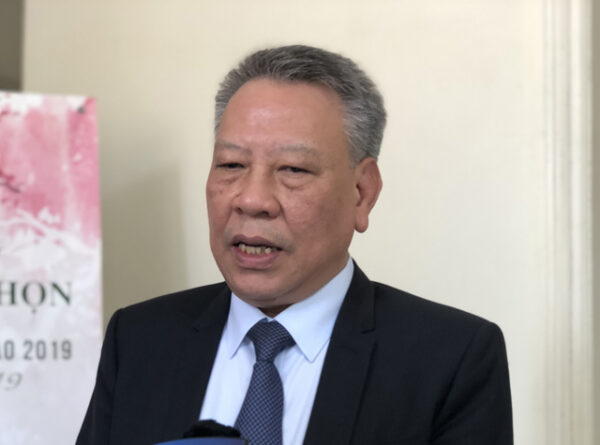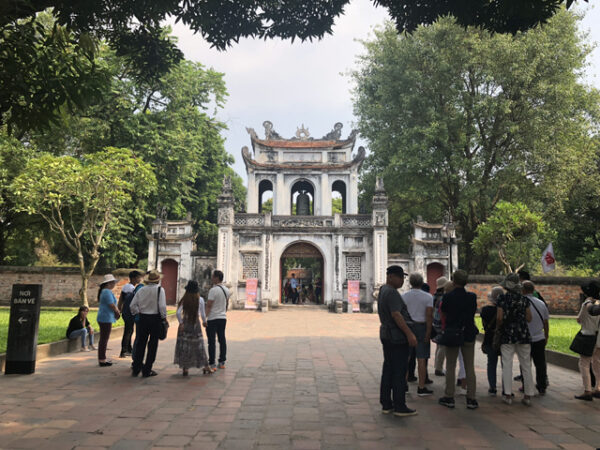– Can you share with readers some results in conservation and promotion of the value of the monument system that Hanoi has achieved in the past year?
– Hanoi is currently the locality with the largest number of relics in the country owning 5,922 relics, of which 2,435 relics are classified at various levels, including 1 relic ranked World Heritage, 17 special national relics, 1,165 national-level ranked relics, 1,382 city-level ranked relics.

Mr. To Van Dong, Director of Hanoi Department of Sports and Culture
The management, conservation and promotion of cultural heritage values in the past year have continued to be stable and paid attention. In 2019, we have implemented projects of restoration and embellishment for 177 relics in the city with a total budget of VND 1,165,724 billion (including VND 282,054 billion from socialization funds). The cases of violations in relic management are reduced due to timely detection, handling and settlement. The Department has coordinated with branches, districts to survey and evaluate the degradation status to submit to the City authority to allocate VND 178.65 billion for supporting the renovation and embellishment of 150 ranked and revolutionary relics with the typical valuable resistance which were seriously degraded in 22 districts, towns in 2020. However, the number of relics with main items degraded was recorded during the inventory of 2013-2015 up to 727 relics (including 448 degraded relics and 253 severely degraded relics), so the funding for renovating and embellishing relics has not met the actual needs.
Also in 2019, the Department completed the application for ranking 51 relics including 1 application submitted to the Prime Minister for recognition of special national monument, 2 national monuments and 48 city-level relics). Monuments and landscapes directly managed by the Hanoi Department of Culture and Sports such as Hoa Lo Prison, Van Mieu – Quoc Tu Giam, Ngoc Son Temple and revolutionary relics, etc. welcomed and served more than 3 million visitors, revenue reached more than VND 87 billion. Also, the relic system in the districts plays an important role in creating tours, routes and cultural and spiritual tourism products that are unique to Hanoi, contributing significantly to the increase the number of tourists coming to the capital over the past time.
– Besides the achieved results, the management, repair and embellishment of monuments in the city must also face difficulties and limitations, Sir?
– As I said, the biggest difficulty right now is that the investment resources for the preservation and restoration of monuments have not met the actual needs. Public-private cooperation in the socialization of relic restoration and embellishment is the direction that many countries in the world and some provinces and cities in the country such as Quang Ninh, Ninh Binh and Quang Nam have carried out. However, this problem is often influenced by many factors and always has two sides. Besides the advantage is the resources from businesses, organizations and the private sector that contribute to “reducing the load” to the state budget in terms of funding, the disadvantage is that some places, businesses and communities during restoring and embellishing relics often follows its subjective will, i.e. constructing new architectural items or adding artifacts and worshiping objects that are incompatible with the landscape and cultural traditions. In addition, the management staff and experts in some districts have not met the professional requirements, leading to advising the local authorities, guiding the community, and enterprises to build the application for relics restoration to be slow and not in line with specialized regulations and lasting. Besides, the looseness and irresponsibility of the management levels also cause many difficulties for the preservation and promotion of the value of the relic system in the city.
Temple of Literature is considered as a pioneer in implementing the strategy of developing the Capital’s cultural industry, contributing to the creation of an innovative city and sustainable development.
– Promoting the values of cultural and historical relics can be seen as a resource to build an innovative and sustainable city. Could you share a few typical models?
– A number of relics have been promoting their values very well, most notably the Hanoi Temple of Literature or Hoa Lo Prison with programs and activities that contribute to asserting the cultural identity of Thang Long – Hanoi. Hanoi Temple of Literature has become a national cultural address which welcoming international heads of state and a favorite destination for tourists, contributing to actively promoting the Capital’s cultural tradition. This year, Hanoi Temple of Literature is considered by many experts to be a pioneer in building typical souvenir products, modern introduction, presentation boards and conducting good heritage education for many objects and ages, etc., implementing the strategy of developing the Capital’s cultural industry, contributing to building an innovative city and sustainable development. Similarly, Hoa Lo Prison relic also has attractive activities to attract visitors and generate its revenue. This relic currently welcomes millions of visitors each year can proceed to autonomy in operating funds without having to use the state budget. Activities at Hoa Lo Prison relic not only mean historical education but also culture and humanities in connecting domestic and international historical witnesses with the capital’s public and visitors, confirms the vitality of the relic in contemporary life today. Such models will be replicated in the near future.

Hoa Lo Prison relic has many interesting activities to attract tourists.
Besides the typical monuments, the districts also do well in preserving and promoting the value of the heritage. These include Walking Street in Hoan Kiem Lake area and adjacent, Hoan Kiem District; Long Bien district with the Tran Vu temple relic and the “Sitting tug of war” heritage in the representative multinational cultural heritage of humanity; Gia Lam district with Bat Trang pottery village and Phu Dong temple; Soc Son district with the relic area of Soc temple; Ba Vi district with the relics of Thuong – Trung – Ha temple of Ba Vi mountain which is closely associated with beliefs and Tan Vien Son Thanh festival; Phuc Tho district and Hat Mon temple or Huong Son scenic spot of My Duc district, etc. These localities not only do well in renovating and preserving but also promote the value of relics in tourism development, bringing revenue to the monument. It is a good sign that cultural heritage has been making an important contribution to the socio-economic development of its resources. This internal strength creates resources for sustainable development for the preservation and promotion of the cultural heritage system of the Capital. Depending on the conditions of each monument, the city will select the appropriate conservation method. Not all monuments are preserved in a way that attracts visitors by all means but will preserve all or promote part of the value of the monument. Conservation methods will be investigated appropriately, flexibly and harmoniously with the general development trend of the country and the world based on local practical conditions. Only then, heritage can last in a sustainable and lasting manner, contributing to the overall development of the Capital’s culture.
– Sincerely thank you for the conversation!
Linh Tam

